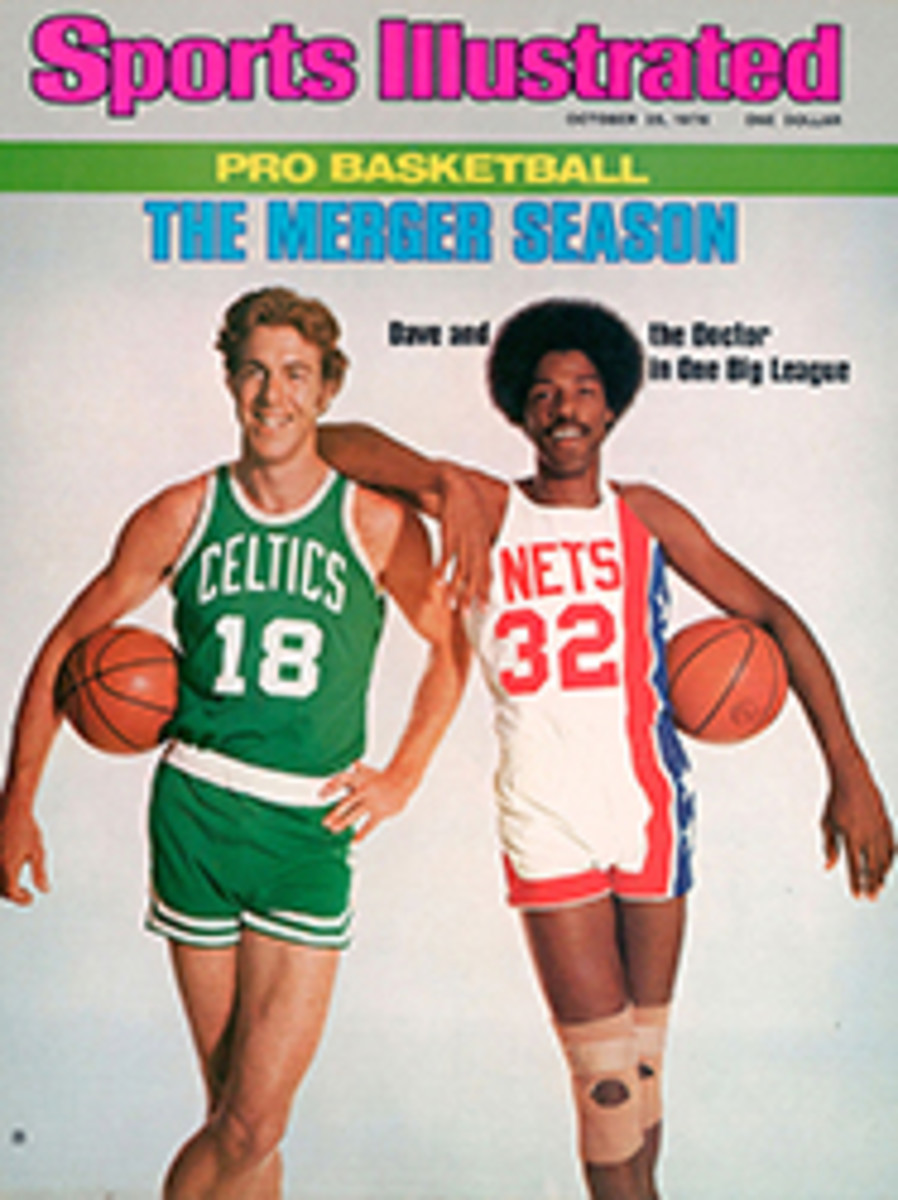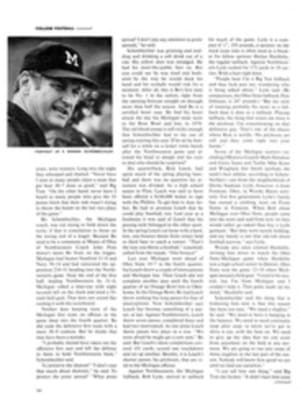
MIDWEST DIVISION
I kind of expected they'd put us in there," says Denver Coach Larry Brown, making "in there" sound as if he meant some kind of medieval torture chamber. He refers to the Midwest Division, the NBA's own Cuckoo's Nest which, after a year of being simply woeful, will once again take its rightful place as the sticks and stones and broken bones division. New boys Denver and Indiana will find that the Midwest is not just up for grabs. It's up for pokes, pushes, kicks and punches in the face.
Denver is not about to run away from the action, but the mercurial Nuggets never stand around long enough for anybody to get a clear crack at them. Denver scored more points per game than anyone last year (122) and won the most games (60) by an average spread of six points. The Nuggets owe much to the aerial magic of David Thompson (26 points per game), but this is a team that uses 10 men and plays the running, passing offense and the pressing, jump-switching defense—a concept as foreign to the Midwest's traditional slowdown, patterned attack as the friendly handshake. Opposite Thompson, Bobby Jones is the perfect defensive forward for a Brown-coached team. He can run with Rick Barry and John Havlicek, jump with Julius Erving and George McGinnis, and shoot like nobody else—he has the best two-year shooting percentage in the league. When Jones does sit down, or when Thompson moves back to guard—which will happen often: "He's easily our best defensive guard," says Brown—in comes Jones' practically identical twin, "Gus Gerard. Then there is the Geritol Squad, ABA original Byron Beck and the legendary Willie Wise. Beck looks like someone Mel Brooks created, but he'll hit his hook until rigor mortis sets in; the 6'6" Wise, a three-time ABA All-Star with a 19-point career average, is a rescued free agent from the defunct Virginia Squires. The guards, Ralph Simpson and Chuck Williams, will get plenty of help—some from Thompson; some from Fatty Taylor, back from a year's exile to Virginia; some from defensive specialist Ted (Hound) McLain, stolen from the Nets; and some from the ever-improving sprite, Monte Towe.
If there is a weakness in the Nuggets, most opponents believe it is at center, where 6'9" Dan Issel sports his gaptoothed glare. But he was Denver's second-leading scorer with 23 points a game, and if he's a bit too slow-footed to chase the likes of Dave Cowens or Alvan Adams, or too small to handle Gilmore or Abdul-Jabbar, Issel is not bothered. "We help each other," he says. And he is not the only center; 7'1" Marvin (Human Eraser) Webster is sound and strong. And Brown is talking about playing the 6'9" Jones at center and moving Issel into the corner at times. Brown's not kidding. "Jones can do anything," he says. So can the Nuggets. Even win the NBA.
If they do, it will be without the help of the division's other Brown, Herb, who coaches Detroit and happens to be Larry's big brother. "My brother and I don't talk," says Larry. "I think he wants to show me up," says Herb. Herb is not so much worried about their first professional clash as he is about his other problems. He has been given an ultimatum: win or else. Brown did win after taking over the club upon Ray Scott's firing last year—10 of the Pistons' last 11 games—only to lose a heroic six-game playoff series to Golden State. But Center Bob Lanier, the team's unquestioned leader, more than once has made known his disgust with Brown's screaming, manic coaching style. Herb is looking at the most talented collection of big men in the league—Lanier, Marvin Barnes, M. L. Carr, Curtis Rowe, Al Eberhard and 6'9" rookie prize Leon Douglas from Alabama—and feeling the heat.
Take Barnes. Barnes' two years with St. Louis produced these numbers: 24.1 points and 13.4 rebounds per game, 15 no-shows. Lanier has taken responsibility for seeing that Barnes is bruising on the court instead of cruising in his Rolls. On the forward line Rowe comes off his best of five inconsistent years, but he has not made management happy with his demands to be traded. Carr, who started opposite Barnes for St. Louis as a rookie last year, is 6'6", 205 and built like a smaller Paul Silas. Eberhard runs through walls. Douglas? "One of the strongest men I ever played against," says Lanier.
Kevin Porter is still favoring the leg he broke and sharing time at one guard with Eric Money. Chris Ford is steady, but not the big guard Brown is looking for. It could be tough John Mengelt or Rutgers rookie Phil Sellers. Or Brown just may not have one.
Larry Costello has been trying to get more aggressiveness out of Milwaukee's 7' Center Elmore Smith for a year now. He may have found a way: match him up in practice against Swen Nater, a bruiser who last played for Virginia. "They were both real happy when the exhibition games started," says Buck publicist John Steinmiller. They had fun with Chicago's Artis Gilmore right away. In a highly physical game, Smith reacted to an elbow from Gilmore by smashing the ball square into his face. Moments later, Nater landed two fists hard in the same spot. Costello was pleased. He would be more pleased if his best defensive forward, David Meyers, hadn't torn up his knee and if Meyers' backup, Junior Bridgeman, hadn't injured an Achilles tendon. That leaves Costello without a veteran strong forward to play opposite Bobby Dandridge. He will go with 6'8" rookie Alex English, a second-round steal from South Carolina. Rookie Quinn Buckner from Indiana will displace Gary Brokaw as a starting guard alongside Brian Winters, the shooting whiz. Behind them is another rookie, Lloyd Walton, a quick penetrator from Marquette.
Chicagoans may have a tough time recognizing their Bulls. In came the 7'2" Gilmore of Kentucky, the plum of the ABA dispersal draft, rookie Scott May of Indiana and two rookie guards, Willie Smith (Missouri) and Keith Starr (Pittsburgh). Also a new coach, Ed Badger, who says the Bulls are going to run this year. Run? A team that always has trouble beating the 24-second clock?
The Bulls will be without Guard Jerry Sloan for the first time in 10 years, and will be operating with Norm Van Lier as their only experienced backcourt man. Veteran Forward Bob Love and Van Lier both profess to be newly inspired. May was to have battled the much improved Mickey Johnson for a starting forward spot, but for the time being is sidelined with mononucleosis. So, depressingly enough, is Jack Marin, another of Badger's veteran forwards. Badger's biggest problem is that lack of another seasoned guard. Second-year man John Laskowski will start, with relief from Smith, a fine shooter out of Missouri who is learning defense, and Starr, a fourth-round pick who could be a sleeper.
The Kansas City Kings could be the sleeper of the division. Phil Johnson was Coach of the Year in '74-'75 with a team he didn't like, then he lost big last season. Fingering his guards, Tiny Archibald and Jimmy Walker, as the core of the problem, Johnson and General Manager Joe Axelson cleared them out. "Last year we couldn't mail a ball to the front line," says Axelson. Now the Kings have Johnson's kind of team. For Archibald the Kings got two Nets: Brian Taylor, an excellent defensive guard, and Jim Eakins, a reliable backup center. From the ABA dispersal draft came Guards Ron Boone, a 22-point scorer, and his St. Louis teammate Mike Barr. From the college draft came 6'10" UCLA Forward Richard Washington. Survivors include Center Sam Lacey, quick Forwards Scott Wedman and Ollie Johnson, and the powerful Bill Robinzine, who only needs to learn not to foul (he led the NBA in disqualifications last year). They all can play the style Johnson coaches: slow, cautious offense, pressure defense. Straight from the Dick Motta school, of which Johnson has been a student since junior high.
Indiana Coach Slick Leonard would like to win some games, sure, but he concedes, "On paper, we're the weakest team comin' in. Maybe even weaker than the paper." The Pacers are not going to lie down, but Leonard does have this intriguing thought in the back of his mind: if the Pacers should somehow finish last in the West and win a coin flip for the No. 1 pick in next year's draft, why there's a pretty good center just 45 miles down the road in Bloomington, name of Kent Benson. Throw Benson in with the amazing Billy Knight, voted the second-best forward in the ABA last year (behind Erving but ahead of David Thompson) and the Pacers' outstanding defensive guard, Don Buse, and they'll have a club something like the one that used to play for the ABA championship. Right now, with second-year man Dan Roundfield at center replacing the injured Len Elmore, Darnell Hillman, Wil Jones and Steve Green the other forwards, plus Darrell Elston, Mike Flynn and the veteran Freddie Lewis at guard, the Pacers look like they're moving, ever backward, toward that pot of gold.
ILLUSTRATION

